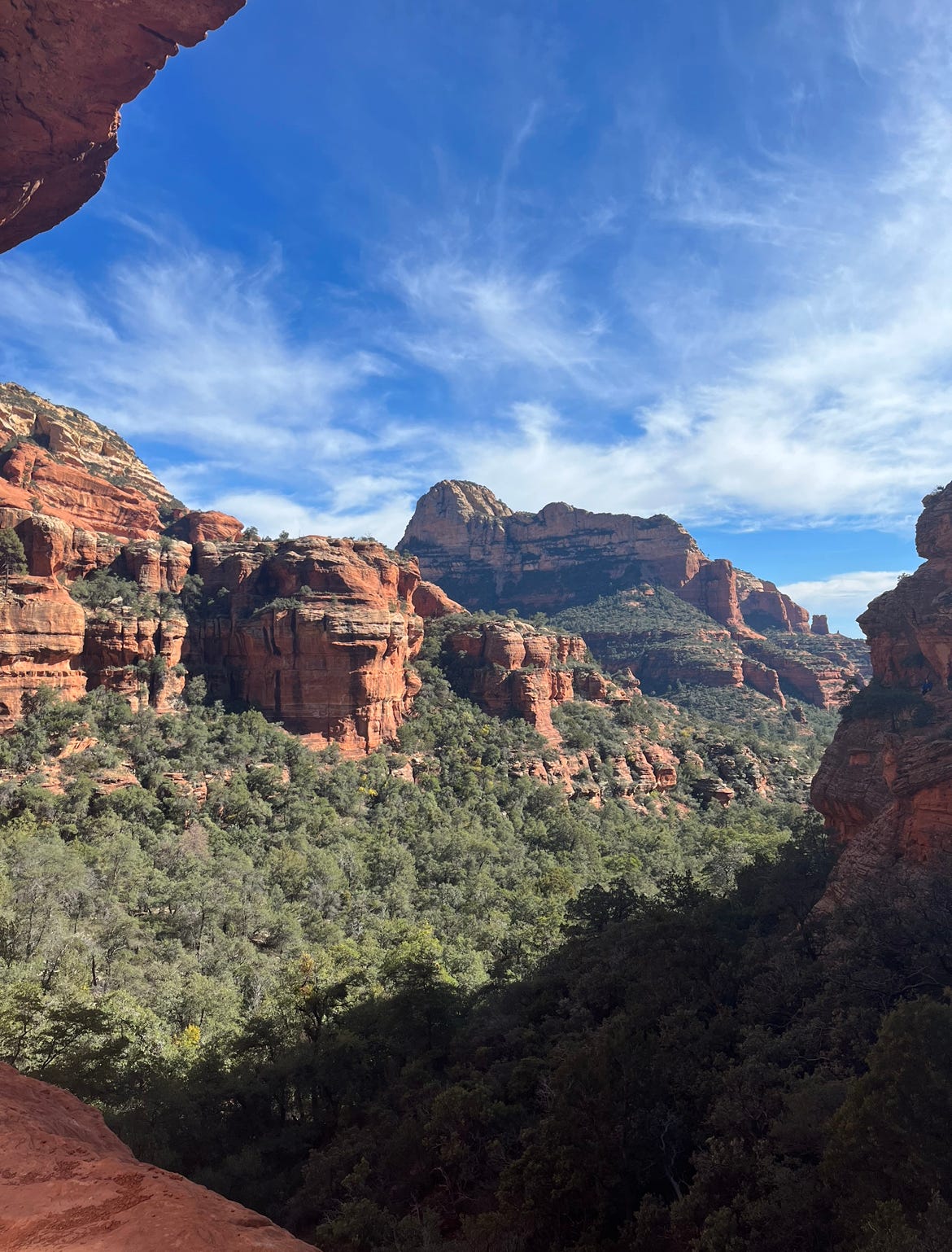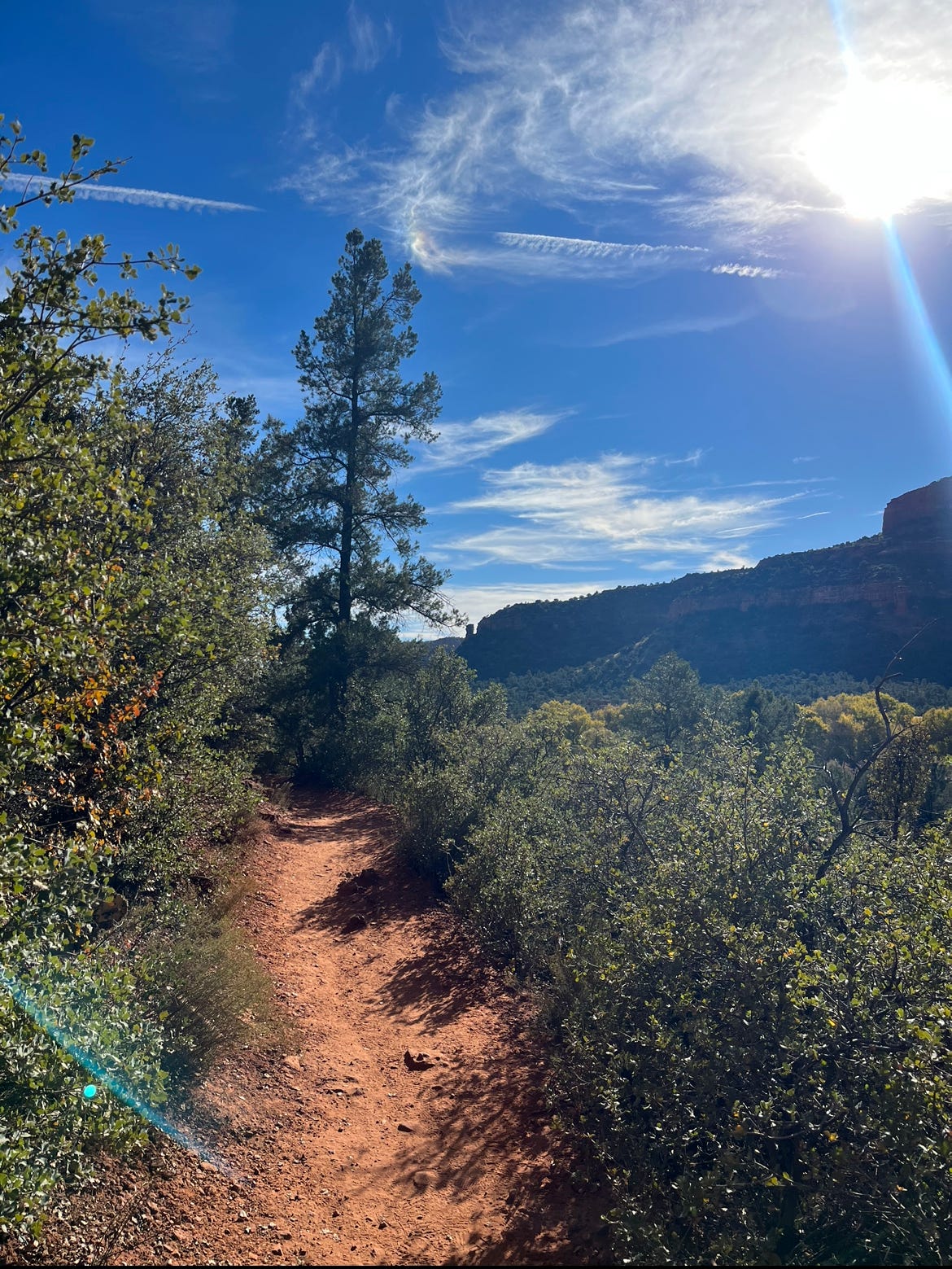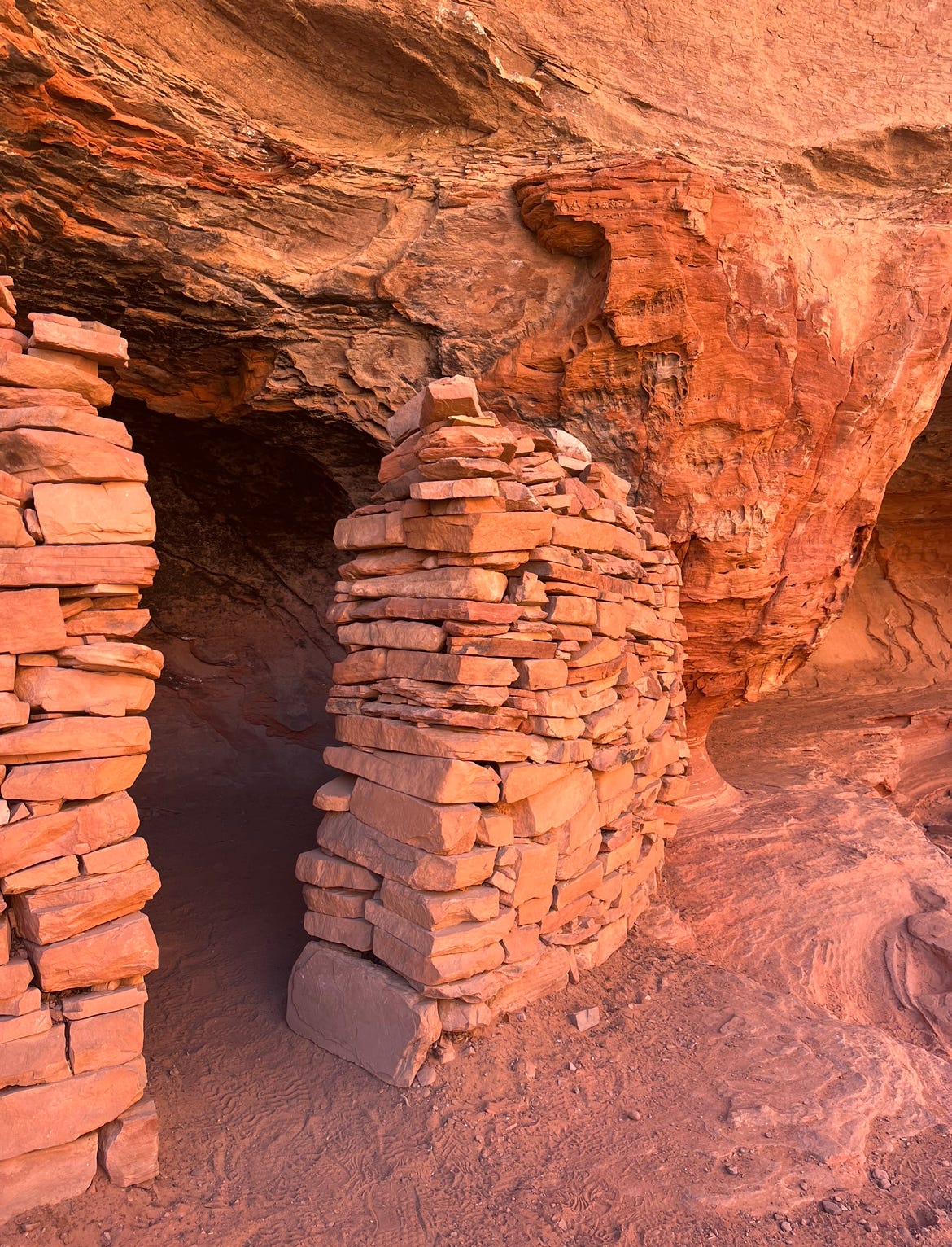About 90 minutes north of Phoenix, scrubby sandstone hills part to reveal striking red peaks. The change is abrupt: one minute I was peering out the windshield at never ending tan plateaus, and the next minute, craggy rust-colored peaks overtook my view. Red rocks spiraled up into the bluest sky, framed by yellowing tree leaves still clinging to their branches. These primary colors recalled past years spent toddling around a Fisher Price play set, but now took shape in the vivid and inviting landscape that would comprise my adult playground for the next few days.
Nestled among these rocks lies Sedona. The town is an assortment of seasonal industries: tours through the backcountry in bright pink Jeeps, sightseeing expeditions via helicopter, all-inclusive resorts with a view, adventure-themed saloons, tarot readings, aura photography and crystallography. Uptown Sedona is little more than a half mile stretch of boutiques, restaurants, gem shops, and tourism offices. The actual town with its boring gas stations and grocery stores, lies far west. From Uptown Sedona, one would almost never guess that the functional areas of town look just like anywhere else.
While it is now a place for woo-woo aunties to get their aura read for $50 or to burn gas by speeding in a side-by-side, the Sedona area is historically home to many groups of indigenous people. The Yavapai and the Tonto Apaches, the Hopi and Navajo have all called red rock country home. Their indelible marks are found in etchings on cliff walls, traditional stone working, and in naming traditions throughout the area. Unfortunately, these rich indigenous cultures have been co-opted and monetized by many white people hawking “native” jewelry throughout town.
It’s a complicated place with a deep history, so I’m splitting our trip into several short pieces. It’s hard to write about all at once. I want to talk about so many different things — parts of the trip, the land, the history, camping with alpacas — I couldn’t possibly ask anyone to read all of that at once. It would take hours.
I’m going a bit backwards by beginning with our last hike in Sedona. Just like the town surrounding it, this trail is a mixture of modern industry and the breathtaking natural world. In the middle of the trail, we walked past a resort nestled into the rocks and it broke my heart. Such a beautiful landscape marred by sprinklers desperately trying to water green grass that does not belong in such a place. The resort was devoid of wildlife, starkly alone, beeping with construction equipment and reeking of gasoline. It was devastating. Fortunately, it’s not visible (or even audible) for most of the 7.0 mile out and back hike. The resort was quickly forgotten, replaced with the awe of being among some of the most gorgeous views I’ve seen in my life.
One of the most traversed trails in red rock country, the Boynton Canyon hike winds through miles of red rocks to reveal stunning vistas. It’s relatively flat, with a few brief climbs off spur trails to incredible viewpoints. This trail is unlike those we had hiked before — its unique geography gives rise to distinctive trees and plants we’d not found elsewhere among the rocks.
Steep canyon walls provide hours of shade from the brutal desert sun, and a creek winding through the canyon feeds the lush forest at its banks. Alligator juniper trees stretch their craggy limbs across the trail, sheltering hikers from the elements for most of the trip. Leaves yellow and twirl down to the ground, cushioning the path.
Almost immediately, a spur trail entices visitors to clamber up a slanted, jagged path toward the Boynton Vista. Home to many vortexes (or vortices if you want to be fancy about it), Sedona claims a deep connection to the earth’s energy field. The air crackles and even the wind feels alive. While Sedona as a whole can be considered a vortex, many people claim to feel vibrations in the earth at specific places, like on a rocky outcropping at the edge of the Boynton Vista spur.
We pressed on, opting to take time for the vortex at the end of our hike, rather than get caught up there before the seven mile trek. Two miles past the first spur lies another, which many seek and fail to find. I loved the mystery of this trail, of people asking politely to be directed toward its secrets. The Subway Cave lies at the far end of Boynton Canyon off this unmarked trail, through a riverbed, and up a fallen rock lined ravine. If successful in finding the cave, travelers are met with some of the most beautiful views they could imagine.
Of course, we found the trail. While there is no sign, and there are dead trees placed across the path — a hiker’s clue to keep on the main path and not stray where the trees lay — a small cairn hinted that this was, in fact, the right way to go. With a quick check of the map to ensure we had hiked the two miles necessary to reach the spur, we took the trail to the right, hoping (and relatively certain) it would lead us to the Subway Cave.
I have to digress to impart some crucial wilderness know-how. In general, it’s absolutely imperative to listen to the clues your path holds. Rocks and trees are often placed along the sides of trails to indicate that hikers should not mistake a deer trail or other deceptive path for their main hike. Ignoring these indicators is the fastest route to being lost in the elements, where one can quickly run out of food and water. It is, therefore, incredibly dangerous not to heed what the trail tells you to do.
In many environments, not only is it treacherous for the person leaving the path, it’s also detrimental to the ecosystem. Straying from the trail can damage delicate plant life and disturb endangered species. Additionally, reforestation and anti-erosion measures are vital to the maintenance of a wilderness we can learn from, but these efforts are seriously hindered by travelers who don’t stick to the path. This is one of the principles of Leave No Trace, which encourages travelers to interact with nature in sustainable ways.
I want to stress that both my partner and myself are experienced in wilderness survival and wilderness medicine. We are conscientious hikers who know and follow the rules of each park we enter. This spur, while unmarked, is well-traveled and has a clear, maintained path all the way to the Subway Cave. To the best of my knowledge, it is totally ok to follow, and does not interfere with environmental protection efforts in the area.

The end of the spur trail forms a steep ramp, slanted at such an extreme angle that many hikers used their hands and knees to crawl up or down. After a brief scramble up the easier path hidden to the left, we walked around a ledge in the canyon wall toward what looked like someone’s house long ago. The inside ceiling was stained with the smoke of fires past, but the protective walls looked newly built.
A petroglyph of a turtle is etched into the canyon wall, and likely has been for centuries. In other similar areas, Pueblo people built dwellings and made petroglyphs, but on this trail, there is no artifact information, and it’s been difficult to find reliable descriptions online. But they’re beautiful to observe, and a reminder that many people walked these paths long before us, and will walk them long after. I couldn’t help but think of whoever may have lived on this cliff wall. How stunning the sunrise must have been each morning, peeking out over these rocks.
Two people were tattooing one another on the ledge, trying to capture the beauty of our surroundings in ink on skin. I observed for a while but didn’t wait to see the final result. I was hungry. After wolfing down lunch, we crossed the canyon to Arch Ruin, a less popular site, perhaps because it is only found by following an even more obscure path. Detailed petroglyphs and remains of homes lay at the base, and a short climb took us under the arch to another vista — this time, of the Subway Cave we had just left. Satisfied with our long hikes and climbs, and with the sun beginning to dip below the canyon wall, we headed back toward the trailhead.
Near the end of our hike, we returned to the Boynton Vista and its vortex. I sat in the shade and meditated for a while to see if I could feel those famous vibrations, or at least some of the uplifting, peaceful, calm, rejuvenating energy that had seemed to possess the person perched atop the rock, playing the pan flute. I didn’t feel any rumblings from the ground or experience a transcendental change within myself, but I did feel better. Whether that was due to the deep spirituality of the vortex or the relaxing pan flute joined by the hum of little metal singing bowls and a nice long pull from my water bottle, I’m not sure. Either way, I felt pure serenity.






